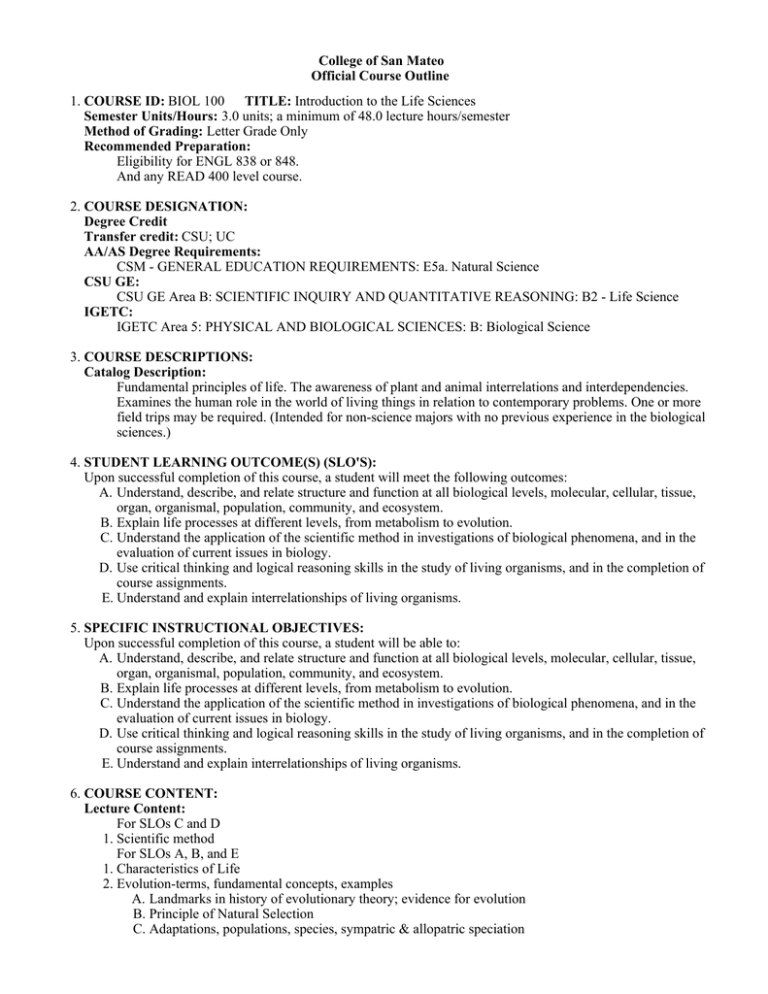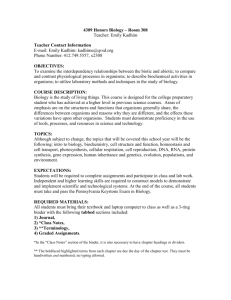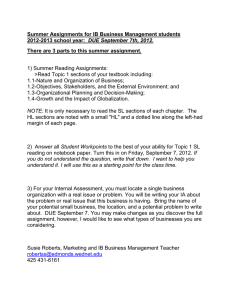College of San Mateo Official Course Outline COURSE ID: Semester Units/Hours:
advertisement

College of San Mateo Official Course Outline 1. COURSE ID: BIOL 100 TITLE: Introduction to the Life Sciences Semester Units/Hours: 3.0 units; a minimum of 48.0 lecture hours/semester Method of Grading: Letter Grade Only Recommended Preparation: Eligibility for ENGL 838 or 848. And any READ 400 level course. 2. COURSE DESIGNATION: Degree Credit Transfer credit: CSU; UC AA/AS Degree Requirements: CSM - GENERAL EDUCATION REQUIREMENTS: E5a. Natural Science CSU GE: CSU GE Area B: SCIENTIFIC INQUIRY AND QUANTITATIVE REASONING: B2 - Life Science IGETC: IGETC Area 5: PHYSICAL AND BIOLOGICAL SCIENCES: B: Biological Science 3. COURSE DESCRIPTIONS: Catalog Description: Fundamental principles of life. The awareness of plant and animal interrelations and interdependencies. Examines the human role in the world of living things in relation to contemporary problems. One or more field trips may be required. (Intended for non-science majors with no previous experience in the biological sciences.) 4. STUDENT LEARNING OUTCOME(S) (SLO'S): Upon successful completion of this course, a student will meet the following outcomes: A. Understand, describe, and relate structure and function at all biological levels, molecular, cellular, tissue, organ, organismal, population, community, and ecosystem. B. Explain life processes at different levels, from metabolism to evolution. C. Understand the application of the scientific method in investigations of biological phenomena, and in the evaluation of current issues in biology. D. Use critical thinking and logical reasoning skills in the study of living organisms, and in the completion of course assignments. E. Understand and explain interrelationships of living organisms. 5. SPECIFIC INSTRUCTIONAL OBJECTIVES: Upon successful completion of this course, a student will be able to: A. Understand, describe, and relate structure and function at all biological levels, molecular, cellular, tissue, organ, organismal, population, community, and ecosystem. B. Explain life processes at different levels, from metabolism to evolution. C. Understand the application of the scientific method in investigations of biological phenomena, and in the evaluation of current issues in biology. D. Use critical thinking and logical reasoning skills in the study of living organisms, and in the completion of course assignments. E. Understand and explain interrelationships of living organisms. 6. COURSE CONTENT: Lecture Content: For SLOs C and D 1. Scientific method For SLOs A, B, and E 1. Characteristics of Life 2. Evolution-terms, fundamental concepts, examples A. Landmarks in history of evolutionary theory; evidence for evolution B. Principle of Natural Selection C. Adaptations, populations, species, sympatric & allopatric speciation D. Microevolution, macroevolution processes, mechanisms, importance of variation D. Microevolution, macroevolution processes, mechanisms, importance of variation E. Origin of Life: earth's history, chemical evolution, levels of organization F. Prokaryotic and eukaryotic domains, kingdoms, evolutionary relationships; endosymbiont hypothesis of eukaryote evolution; evolution of multicellular organisms. Introduction to the Tree of Life. For SLOs A, B, and E 1. Ecology-terms, fundamental concepts, examples A. Community, abiotic, biotic environment, niche, producer, consumer, trophic levels B. Energy flow, mass cycles, food webs & pyramids C. Species interactions, coevolution 2. Chemistry A. Atomic and molecular structure B. Water chemistry, importance to living systems C. Molecules of cells; interactions with water, organic substances, basic structure and characteristics of carbyhydrates, lipids, proteins, nucleic acids D. Proteins: diverse functions, information content/specifcity E. Energy conversions: metabolic pathways, roles of enzymes in cell metabolism F. Photosynthesis, Cellular respiration For SLOs A, B, and E 1. Molecular Biology A. DNA structure replication B. RNA, genetic code C. Protein synthesis D. Mutation E. Mendelian inheritance-terms, fundamental concepts, examples 2. Cells A. General characteristics, prokaryotic structure, eukaryotic organelles B. Membrane structure and function; transport C. Cell division and organismal reproduction; asexual and sexual reproduction, mitosis, meiosis, haploid, diploid cells For SLOS A, B, C, D, and E 1. Survey of traditional five kingdoms, and discussion of current concepts/views of classification. Diversity of life as portrayed in the Tree of Life. A. Metabolic diversity, roles in ecosystems, ineractions with humans, of Monera/Bacteria & Archaea, Protista, Fungi, Plants, Animals B. Advantages, problems of aquatic and terrestrial living for algae/plants, animals C. Plants: trends in evolution, characteristics of major groups of land plants, seeds, flowers, fruits. Current classification schemes. D. Animals: trends in evolution, characteristics of major phyla; Vertebrates trends in evolution, characteristics of classes. Current classification schemes. 7. REPRESENTATIVE METHODS OF INSTRUCTION: Typical methods of instruction may include: A. Lecture B. Activity C. Discussion D. Field Experience E. Field Trips F. Guest Speakers G. Service Learning H. Other (Specify): Discussions, group activities, critique of videos or documentaries, field trip report and in-class discussion, written papers. 8. REPRESENTATIVE ASSIGNMENTS Representative assignments in this course may include, but are not limited to the following: Writing Assignments: 1. Homework assignments related to textbook readings and supplemental to textbook readings. Some of the assignments may include answering review questions, short essays, or a report on a current issue in biology. 2. Term paper that includes a library search of appropriate valid scientific sources, and proper citation of sources. 3. Report based on a field trip. 4. Report based on a service learning activity. 5. Metacognitive (reading) log based on short articles or textbook chapters. Reading Assignments: 1. Reading assignments for each of the textbook chapters. 2. Reading selected papers from the library journal database. 3. Metacognitive (reading) log based on short articles or textbook chapters. Other Outside Assignments: 1. Review of several biology videos housed in the library database collection. 2. Review of appropriate documentaries from the Nature or Nova PBS website. 3. Visit to a local botanical garden or park to study biomes or biological phenomena. 9. REPRESENTATIVE METHODS OF EVALUATION Representative methods of evaluation may include: A. Class Participation B. Class Work C. Exams/Tests D. Field Trips E. Homework F. Oral Presentation G. Papers H. Projects I. Quizzes J. Written examination K. Objective exams (true/false, multiple choice, fill-in blanks), essays, term paper, take-home exams, reports on videos, reports on journal articles, reading logs, and oral presentations. Weekly homework assignments. Participation in field trips, in class discussions, and in group activities. 10. REPRESENTATIVE TEXT(S): Possible textbooks include: A. Eric J. Simon, Jean L. Dickey and Jane B. Reece. Essentials of Biology, 5 ed. Pearson, 2012 B. Jane B. Reece, Martha R. Taylor, Eric J. Simon and Jean L. Dickey. Biology: Concepts and Connections, 7th ed. Pearson, 2011 C. Cecie Starr, Christine Evers, and Lisa Starr . Biology: Concepts and Applications, 8th ed. Cengage Learning, 2010 Origination Date: August 2010 Curriculum Committee Approval Date: October 2013 Effective Term: Fall 2014 Course Originator: Tania Beliz


